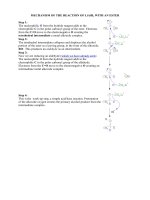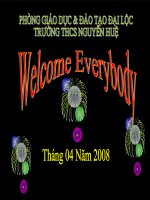10 common misunderstanding of the WTO
Bạn đang xem bản rút gọn của tài liệu. Xem và tải ngay bản đầy đủ của tài liệu tại đây (910.07 KB, 14 trang )
W
ORLD
T
RADE
O
RGANIZATION
Is it a dictatorial tool of the rich and powerful?
Does it destroy jobs? Does it ignore the concerns of
health, the environment and development?
Emphatically no.
Criticisms of the WTO are often based on fundamental
misunderstandings of the way the WTO works.
10 common misunderstandings
about the WTO
The debate will probably never end. People have different views of
the pros and cons of the WTO’s “multilateral” trading system. Indeed, one
of the most important reasons for having the system is to serve as a
forum for countries to thrash out their differences on trade issues.
Individuals can participate, not directly, but through their governments.
However, it is important for the debate to be based on a proper under-
standing of how the system works. This booklet attempts to clear up
10 common misunderstandings.
The 10 misunderstandings
1. The WTO dictates policy
2. The WTO is for free trade at any cost
3. Commercial interests take priority over development …
4. … and over the environment
5. … and over health and safety
6. The WTO destroys jobs, worsens poverty
7. Small countries are powerless in the WTO
8. The WTO is the tool of powerful lobbies
9. Weaker countries are forced to join the WTO
10. The WTO is undemocratic
1
The WTO does not tell governments
how to conduct their trade policies.
Rather, it’s a “member-driven”
organization.
That means:
• the rules of the WTO system are
agreements resulting from
negotiations among member
governments,
• the rules are ratified by members’
parliaments, and
• decisions taken in the WTO are
virtually all made by consensus among
all members.
In other words, decisions taken in the
WTO are negotiated, accountable and
democratic.
The only occasion when a WTO body
can have a direct impact on a
government’s policies is when a
dispute is brought to the WTO and if
that leads to a ruling by the Dispute
Settlement Body (which consists of all
members). Normally the Dispute
Settlement Body makes a ruling by
adopting the findings of a panel of
experts or an appeal report.
Even then, the scope of the ruling is
narrow: it is simply a judgement or
interpretation of whether a
government has broken one of the
WTO’s agreements—agreements that
the infringing government had itself
accepted. If a government has broken
a commitment it has to conform.
In all other respects, the WTO does
not dictate to governments to adopt
or drop certain policies.
As for the WTO Secretariat, it simply
provides administrative and technical
support for the WTO and its
members.
In fact: it’s the governments who
dictate to the WTO.
The WTO does NOT tell governments what to do
1.
2
The WTO is member-driven
3
2.
It’s really a question of what countries
are willing to bargain with each other,
of give and take, request and offer.
Yes, one of the principles of the WTO
system is for countries to lower their
trade barriers and to allow trade to
flow more freely. After all, countries
benefit from the increased trade that
results from lower trade barriers.
But just how low those barriers should
go is something member countries
bargain with each other. Their
negotiating positions depend on how
ready they feel they are to lower the
barriers, and on what they want to
obtain from other members in return.
One country’s commitments become
another country’s rights, and vice
versa.
The WTO’s role is to provide the
forum for negotiating liberalization. It
also provides the rules for how
liberalization can take place.
The rules written into the agreements
allow barriers to be lowered gradually
so that domestic producers can adjust.
The WTO is NOT for free trade at any cost
They have special provisions that take
into account the situations that
developing countries face. They also
spell out when and how governments
can protect their domestic producers,
for example from imports that are
considered to have unfairly low prices
because of subsidies or “dumping”.
Here, the objective is fair trade.
Just as important as freer trade—
perhaps more important—are other
principles of the WTO system. For
example: non-discrimination, and
making sure the conditions for trade
are stable, predictable and trans-
parent.
It all depends on what
countries want to bargain
4
The WTO agreements are full of
provisions taking the interests of
development into account.
Underlying the WTO’s trading system
is the fact that freer trade boosts
economic growth and supports
development. In that sense, commerce
and development are good for each
other.
At the same time, whether or not
developing countries gain enough
from the system is a subject of
provisions of the WTO agreements.
Least-developed countries receive
special treatment, including
exemption from many provisions.
The needs of development can also be
used to justify actions that might not
normally be allowed under the
agreements, for example governments
giving certain subsidies.
And the negotiations and other work
launched at the Doha Ministerial
Conference in November 2001
include numerous issues that
developing countries want to pursue.
The WTO is NOT only concerned
about commercial interests.
This does NOT take priority over development
3.
continuing debate in the WTO. But
that does not mean to say the system
offers nothing for these countries. Far
from it. The agreements include many
important provisions that specifically
take developing countries’ interests
into account.
Developing countries are allowed
more time to apply numerous
Sustainable development
is a principal objective









